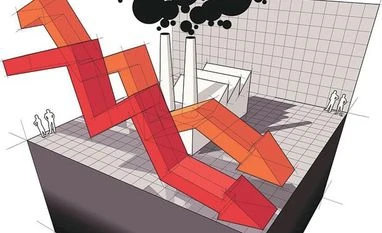Roiled by unprecedented frauds and surging bad debt, the nation’s state-run banks have returned the least to investors this year. However, investors’ belief in the potential of Asia’s No. 3 economy shows in the fact that its newest lenders offer the best returns, and a clutch of private Indian banks are among the world’s most expensive.
For instance, AU Small Finance Bank Ltd.’s return-on-equity, a measure of profitability, was 56 percent compared with about 15 percent for China Construction Bank, 11 percent for JPMorgan Chase & Co. and an average 11.3 percent across 430 global lenders with a market cap of over $2 billion.
“India’s banks have had a sharply divided run -- while consumer banks are riding the crest of consumption and strong and good quality credit demand, wholesale banks are saddled with restructuring challenges of the economy,” said Aditya Narain, an analyst at Edelweiss Securities Ltd. “More tellingly, credit challenges faced by wholesale banks have led to them becoming significantly risk averse, opening up a very large market for well capitalized and confident retail banks to aggressively make marketshare gains.”
Fresh Challengers
A decision by former central bank Governor Raghuram Rajan to create new banks for the first time in more than a decade have yielded two fresh lenders that investors are bullish about. Singapore’s state investment firm Temasek Holdings Pte bought about 5 percent of AU Small Finance Bank Ltd. for $147 million this month and Goldman Sachs Group Inc. this month initiated coverage on Bandhan Bank Ltd. with a buy call.
There’s also about a year to go for national elections, a period during which the government spends more on the hinterland to win votes. Bandhan is focused on the underbanked regions of eastern India. “This is a high-yield business,” said Jaikishan Parmar, an analyst at Angel Broking Ltd. “We expect that Bandhan would continue to grow at a healthy rate and maintain higher net interest margins.”
Indian private-sector banks are also among the most richly valued. HDFC Bank Ltd. in January became only the third Indian company whose market cap has crossed the 5 trillion rupee ($73 billion) mark and Goldman sees it hitting $100 billion by 2020. The lender last month reported the strongest fee income in the past eight quarters and retail loans form 70 percent of its total lending. IndusInd Bank Ltd. trimmed its exposure to companies rated BBB and below to less than 38 percent from more than 48 percent a year ago. Kotak Mahindra Bank Ltd. retained its strong credit growth without worsening asset quality.
The key risk for Kotak Mahindra stems from continued stress in the economy, which could hit demand for commercial vehicles and construction equipment, according to Edelweiss’s Narain. The same could be said for Kotak’s peers as Goldman’s economists trimmed their growth forecast for India amid concerns that woes in the state-run bank sector are worse than thought. Bad loans across government-controlled banks are more than double total market cap.
State-run banking sector is among the biggest threats to India's economy
State Bank of India, the nation’s biggest lender by assets, reported a record $1 billion loss this week for the quarter ended March 31 as provisions surged and rival Punjab National Bank reported India’s largest-ever bank loss after a $2 billion fraud came to light. Half of India’s 22 state-run banks with 20 percent of the sector’s total loans are under the regulator’s strict Prompt Corrective Action program. Five more -- some 16 percent of advances -- could be brought into the framework that restricts lending and expansion, according to Edelweiss.
Despite the government’s “recapitalization of public sector banks, they are likely to face challenges to meet the regulatory capital ratios amid mounting credit provisions,” said Karthik Srinivasan, an analyst at ICRA Ltd. The local unit of Moody’s Investors Service estimates lending by India’s overall banking sector will grow about 8 percent in the year through March 2019, even though private banks will expand credit by some 25 percent.
Disclaimer - Kotak Mahindra and associates are significant shareholders in Business Standard Pvt Ltd
To read the full story, Subscribe Now at just Rs 249 a month
Already a subscriber? Log in
Subscribe To BS Premium
₹249
Renews automatically
₹1699₹1999
Opt for auto renewal and save Rs. 300 Renews automatically
₹1999
What you get on BS Premium?
-
Unlock 30+ premium stories daily hand-picked by our editors, across devices on browser and app.
-
Pick your 5 favourite companies, get a daily email with all news updates on them.
Full access to our intuitive epaper - clip, save, share articles from any device; newspaper archives from 2006.
Preferential invites to Business Standard events.
Curated newsletters on markets, personal finance, policy & politics, start-ups, technology, and more.
Need More Information - write to us at assist@bsmail.in
)